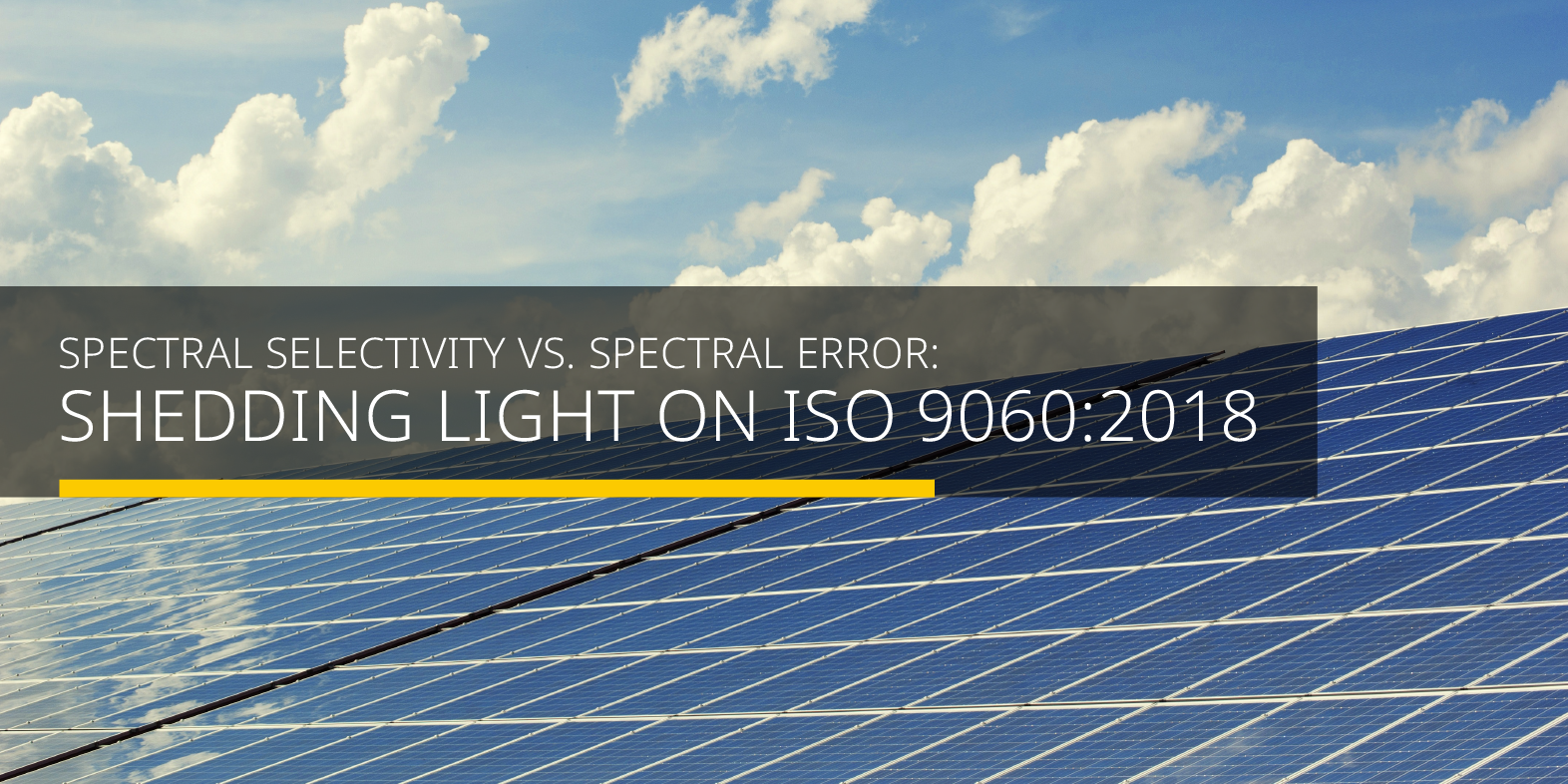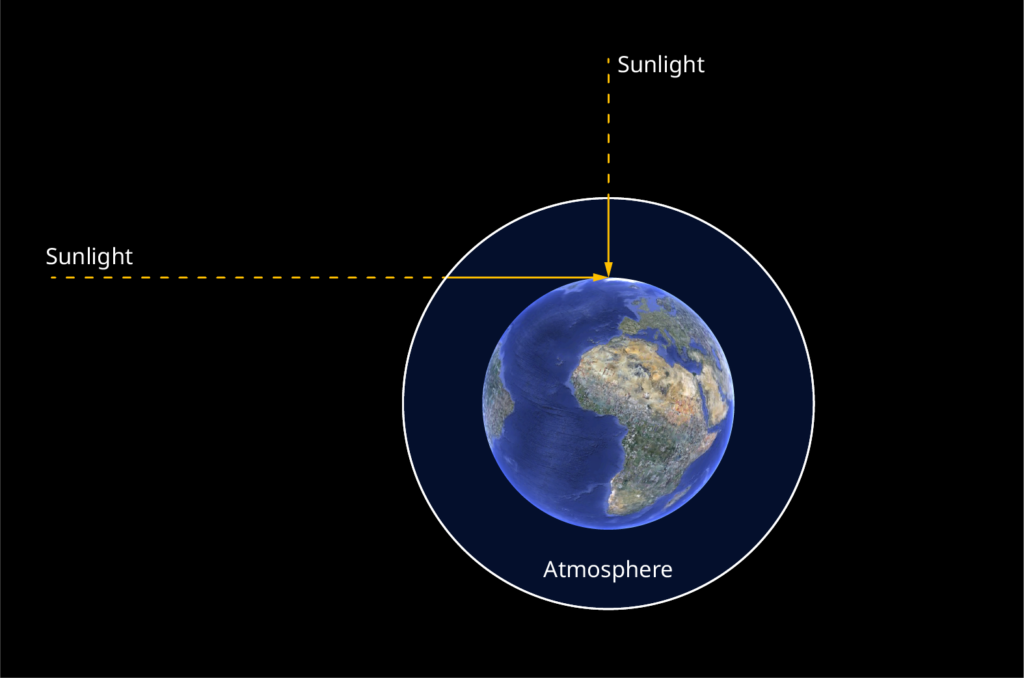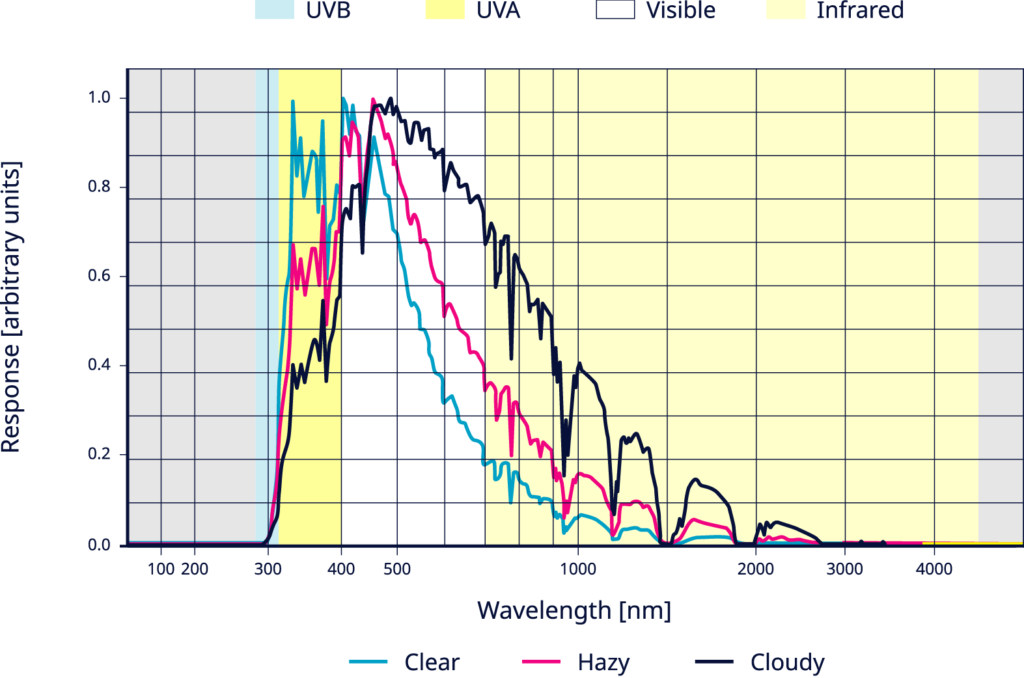In late 2018, the ISO 9060 standard for solar radiometers underwent a remarkable update that brought significant changes on the classification of solar radiation measurement quality. At first glance, ISO 9060:2018 appears to be mainly a renaming of radiometer classification launched in the original version from 1990. But, as often, the devil is in the details and still causing a lot of confusion within the solar industry. In this article, we shed light on the update and explain the difference between the spectral selectivity and the newly introduced spectral error.
But let’s start with the basics. ISO 9060 is titled ‘Solar energy – Specification and classification of instruments for measuring hemispherical solar and direct solar radiation’. It defines what a pyranometer is for measuring global horizontal or global tilted irradiance (GHI and GTI) and, when shaded, diffuse horizontal irradiance (DHI). It also defines what is a pyrheliometer for measuring direct normal irradiance (DNI).
More than a renaming
There are several changes in pyranometer specifications between ISO 9060:1990 and the latest update ISO 9060:2018. The 2018 version states that the newly introduced Class A is ‘roughly corresponding’ to 1990 Secondary Standard, Class B to First Class and Class C to Second Class. ‘Roughly’ is the correct term; the performance parameters, and testing requirements, differ between the 1990 and 2018. However, it is generally the case that in terms of the uncertainty of field irradiance measurements by ISO 9060 pyranometers:
ISO 9060:1990 | ISO 9060:2018 |
– | Class C |
Second Class | Spectrally Flat Class C |
First Class | Spectrally Flat Class B |
Secondary Standard | Spectrally Flat Class A |
So far, so good. But the most difficult aspect to understand the changes between 1990 and 2018 versions of the ISO 9060 standard is the issue of spectral response/error/sensitivity/selectivity.
Broadly speaking, the 2018 update introduced a new parameter to characterize the spectral properties of a radiometer and how it reacts on different parts of light, more precisely photons with different wavelengths. Different to the Spectral Selectivity from the 1990 version, the Spectral Error considers the important fact that the composition of sunlight, the spectrum, varies depending on the time of day in a way more relevant for the application of solar measurements. That said, the new 2018 version reflects the actual wavelength range of sunlight much better than its predecessor. Additionally, by introducing the new Class C on the entry level, the standard now covers well-built photodiode radiometers, too, that have not been covered in the old version.
Let’s go more into detail now.
ISO 9060:1990: Spectral Selectivity
The ISO 9060 standard was written for solar energy purposes to specify the minimum performance requirements for pyranometers and pyrheliometers in three classifications.
The parameters specified are: response time, zero off-sets, non-stability, non-linearity, directional response (not applicable to pyrheliometers), spectral selectivity, temperature response and tilt response.
Depending upon the sky conditions, 97% to 99% of all the solar radiation (GHI) arriving at the Earth’s surface is the wavelength range from 300 nm to 3000 nm (0.3 µm to 3.0 µm). This is way more than what our eyes can see, regarding the range of visible light spanning from 380 nm to 800 nm.
Ideally, a solar energy radiometer should have a flat response over a wide spectral bandwidth, to measure all the available incoming solar energy independent of types of PV modules or solar collectors used.
The key wavelength range for photovoltaic materials is from 350 nm to 1500 nm (0.35 µm to 1.5 µm). In ISO 9060:1990 this ’flatness’ of response is defined as ‘spectral selectivity’, the deviation from the mean response within the range from 350 nm to 1500 nm.
The limits for pyranometers are, according to ISO 9060:1990:
Secondary Standard | ± 3% |
First Class | ± 5% |
Second Class | ± 10% |
To comply with this requirement, pyranometers usually have a ‘thermoelectric’ type detector with a black coating that absorbs the incoming radiation, heats up a thermopile, and converts the temperature rise into a small voltage. Therefore, the heating properties of the coating covering the detector are a key component to a radiometer’s quality. In the graph below, you can see the constant absorption properties of the Kipp & Zonen thermopile detectors in the range from 350 nm to 1500 nm. The spectral response of the coating is essential to build an accurate and reliable radiometer.

Photoelectric sensors, including silicon cells and photodiodes, have a limited and uneven spectral response that does not meet the spectral selectivity specifications for a pyranometer (or pyrheliometer) as defined by ISO 9060:1990; and thus, have to be described as a ‘Silicon Pyranometer’, or similar terminology.
The graphs below show a typical clear sky solar radiation spectrum at sea level and the response of an entry-level glass-dome thermopile pyranometer, such as the Kipp & Zonen CMP3 and SMP3 models. Also, for a typical silicon photodiode sensor, like the Kipp & Zonen SP Lite2 and RT1. The spectra are normalized to the peak/maximum being 100% for easy comparison.
All Kipp & Zonen CMP series and SMP series pyranometers, and the CM4 high temperature pyranometer, have a spectral selectivity of < 3%. These models all meet the ISO 9060:1990 Secondary Standard requirement in this respect.
Now, let’s jump back to the new standard.
ISO 9060:2018: Spectral Error
The updated Second Edition of ISO 9060 was published in November 2018.
The main update relates to spectral response, the change is from spectral selectivity of 1990 to ‘clear sky irradiance spectral error’ in 2018. With that, the authors of the standard took into consideration changing characteristics of the sunlight depending on the daytime and the weather. Another intention of this change is to permit certain types of photoelectric sensor, including well-designed silicon cells and photodiodes, to be classified as an entry-level ‘pyranometer’.
The 2018 standard should provide a better and much more realistic idea of the field measurement errors that can be expected due to the spectral response of a radiometer under various conditions. The relative air mass (thickness of the atmosphere) changes with the solar zenith angle. When the sun is low in the sky the direct beam comes through more atmosphere and the spectrum of the light changes.
Sun at Solar Zenith Angle of 0° | AM = 1 |
Sun at Solar Zenith Angle of 48.2° | AM = 1.5 |
Solar Zenith Angle of 85° | AM = 11.4 |
Obviously, the amount of air increases when the sun hangs low at the horizon. Thus, the geometrical relationship breaks down beyond Solar Zenith Angle of 85° which is equivalent to a setting sun.
Another phenomenon to be considered: the spectral shift
Traveling through the atmosphere, the spectrum of the sunlight changes. The short wavelengths (ultraviolet and blue) are absorbed and scattered and the spectrum shifts towards the longer wavelengths (red and infrared). This also happens with cloud cover, increasing concentration of aerosols and particulates in the atmosphere and decreasing visibility. Obviously, the fixed approach from the 1990 version does not reflect the reality and an update made perfect sense.
Calculation of the spectral error
To consider different sky and atmosphere conditions affecting the actual sunlight spectrum, nine different test spectra representing various atmospheric and daytime situations are evaluated relative to the reference spectrum from another standard, the IEC 60904-3 (2016). The test spectra are provided on the ISO website under ISO 9060 edition 2.
The spectral error is calculated by comparing the relative spectral response of the respective radiometer with the reference spectrum to the response for the test spectra. The spectral response is an individual attribute of a radiometer and a quality characteristic. For each test spectrum, an error is calculated that depends on the instrument’s reaction regarding the wavelength distribution. Out of the nine spectra, the biggest error defines the radiometer’s spectral error.
The limits for pyranometers are:
Class A | ± 0.5% (0.1%) |
Class B | ± 1% (0.5%) |
Class C | ± 5% (1%) |
Kipp & Zonen CMP series and SMP series pyranometers, and the CM4 high temperature pyranometer, meet the appropriate classification limits for spectral error Class A by a large margin. The spectral errors are <0.16%.
The meaning of Spectrally Flat
In addition, if the pyranometer has a spectral selectivity of less than 3% (guard bands 2%) in the wavelength range from 350 nm to 1500 nm (0.35 µm to 1.5 µm) it can be termed ‘Spectrally Flat’.
In effect, this is the criteria for a ISO 9060:1990 Secondary Standard pyranometer and it is more strict than the 1990 First Class and Second Class pyranometers limits.
Kipp & Zonen Pyranometer ISO 9060 Classifications
Kipp & Zonen CMP series and SMP series pyranometers, and the CM4 high temperature pyranometer meet the appropriate classification limits for spectral error and have a spectral selectivity of < 3%. So, they all meet the ISO 9060:2018 Spectrally Flat criteria.
ISO 9060:2018 | Class C | Spectrally Flat Class C | Spectrally Flat Class B | Spectrally Flat Class A |
ISO 9060:1990 | Not allowed | Second Class | First Class | Secondary Standard |
Performance | Lower | → | → | Higher |
Passive pyranometers | SP Lite2 (Fast Response) | CM4 CMP3 | CMP6 | CMP10 CMP21 CMP22 |
Smart pyranometers | RT1 | SMP3 | SMP6 | SMP10 SMP12 (new 2022) SMP22 |
Note: ISO 9060:2018 Class A pyranometers must be individually tested to ensure that their temperature and directional responses meet the requirements of the standard.
Learn more in our Standards Whitepaper
In solar energy there are a number of international standards to consider when it comes to PV plant operation and maintenance.We have summarized the most relevant ISO and IEC standards that apply to weather monitoring in a whitepaper. Download it here for free.







